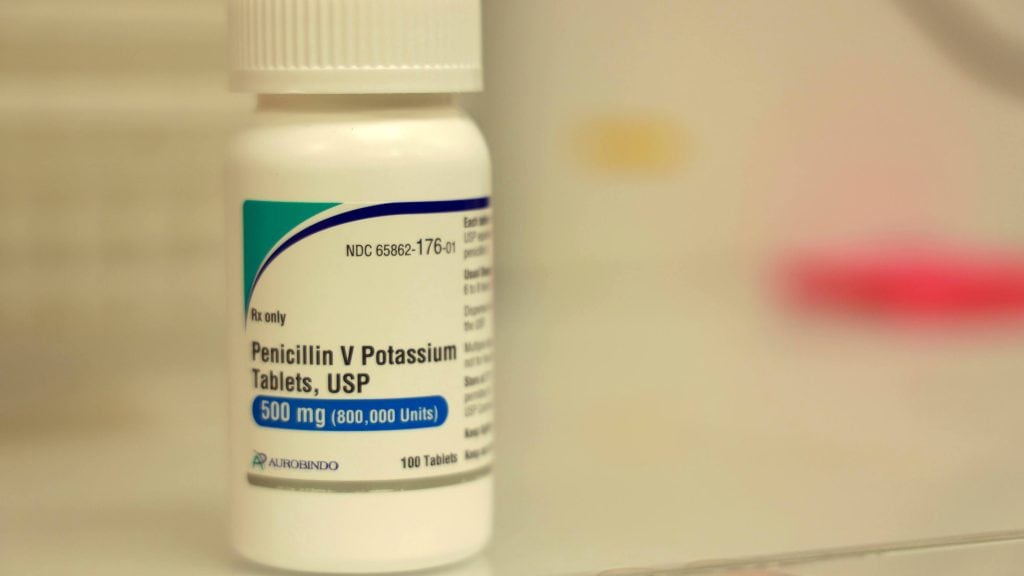Overview
Penicillin allergy is an abnormal reaction of your immune system to the antibiotic drug penicillin. Penicillin is prescribed for treating various bacterial infections.
Common signs and symptoms of penicillin allergy include hives, rash and itching. Severe reactions include anaphylaxis, a life-threatening condition that affects multiple body systems.
Research has shown that penicillin allergies may be over-reported — a problem that can result in the use of less-appropriate and more-expensive antibiotic treatments. Therefore, an accurate diagnosis is needed when penicillin allergy is suspected to ensure the best treatment options in the future.
Other antibiotics, particularly those with chemical properties similar to penicillin, also can result in allergic reactions.
Symptoms
Signs and symptoms of penicillin allergy often occur within an hour after taking the drug. Less commonly, reactions can occur hours, days or weeks later.
Penicillin allergy signs and symptoms may include:
- Skin rash
- Hives
- Itching
- Fever
- Swelling
- Shortness of breath
- Wheezing
- Runny nose
- Itchy, watery eyes
- Anaphylaxis

Drug rash
A drug rash usually starts within two weeks of taking a new medication and begins as discrete red spots that spread, covering large areas of the body.
Anaphylaxis
Anaphylaxis is a rare, life-threatening allergic reaction that causes the widespread dysfunction of body systems. Signs and symptoms of anaphylaxis include:
- Tightening of the airways and throat, causing trouble breathing
- Nausea or abdominal cramps
- Vomiting or diarrhea
- Dizziness or lightheadedness
- Weak, rapid pulse
- Drop in blood pressure
- Seizures
- Loss of consciousness
Delayed reactions resulting from penicillin allergy
Less-common penicillin allergy reactions occur days or weeks after exposure to the drug and may persist for some time after you stop taking it. These conditions include:
- Serum sickness, which may cause fever, joint pain, rash, swelling and nausea
- Drug-induced anemia, a reduction in red blood cells, which can cause fatigue, irregular heartbeats, shortness of breath, and other signs and symptoms
- Drug reaction with eosinophilia and systemic symptoms (DRESS), which results in rash, high white blood cell counts, general swelling, swollen lymph nodes and recurrence of dormant hepatitis infection
- Stevens-Johnson syndrome or toxic epidermal necrolysis, which involves severe blistering and peeling of the skin
- Inflammation in the kidneys (nephritis), which can cause fever, blood in the urine, general swelling, confusion, and other signs and symptoms
Adverse events that are not allergic reactions
You may experience side effects of penicillin — as happens with other medications — that are not an allergic reaction to the drug. Depending on the type of penicillin, common side effects may include mild nausea or diarrhea, headache, or vaginal itching. Signs or symptoms of an infection for which you are being treated — or unrelated symptoms — also may be mistaken as an allergic drug reaction.
When to see a doctor
See your doctor as soon as possible if you experience signs or symptoms of penicillin allergy. It's important to understand and discuss what is an allergic reaction, what is a typical side effect and what you can tolerate in taking a medication.
Call 911 or emergency medical help if you experience signs of a severe reaction or suspected anaphylaxis after taking penicillin.
From Mayo Clinic to your inbox
Causes
Penicillin allergy occurs when your immune system becomes hypersensitive to the drug — mistakenly reacting to the drug as a harmful substance, as if it were a viral or bacterial infection.
Before the immune system can become sensitive to penicillin, you have to be exposed to the medication at least once. If and when your immune system misidentifies penicillin as a harmful substance, it develops an antibody to the drug.
The next time you take the drug, these specific antibodies flag it and direct immune system attacks on the substance. Chemicals released by this activity cause the signs and symptoms associated with an allergic reaction.
Previous exposure to penicillin may not be obvious. Some evidence suggests that trace amounts of it in the food supply may be sufficient for a person's immune system to create an antibody to it.
Penicillins and related drugs
Penicillins belong to a class of antibacterial drugs called beta-lactam antibiotics. Although the mechanisms of the drugs vary, generally they fight infections by attacking the walls of bacterial cells. In addition to penicillins, other beta-lactams more commonly associated with allergic reactions are a group called cephalosporins.
If you've had an allergic reaction to one type of penicillin, you may be — but are not necessarily — allergic to other types of penicillin or to some cephalosporins.
Penicillins include:
- Amoxicillin
- Ampicillin
- Dicloxacillin
- Nafcillin
- Oxacillin
- Penicillin G
- Penicillin V
- Piperacillin
- Ticarcillin
Cephalosporins include:
- Cefaclor
- Cefadroxil
- Cefazolin
- Cefdinir
- Cefepime (Maxipine)
- Cefotetan
- Cefprozil
- Cefuroxime
- Cephalexin (Keflex)
Risk factors
While anyone can have an allergic reaction to penicillin, a few factors can increase your risk. These include:
- A history of other allergies, such as food allergy or hay fever
- Allergic reaction to another drug
- A family history of drug allergy
- Increased exposure to penicillin, because of high doses, repetitive use or prolonged use
- Certain illnesses commonly associated with allergic drug reactions, such as infection with human immunodeficiency virus (HIV) or the Epstein-Barr virus
Prevention
If you have a penicillin allergy, the simplest prevention is to avoid the drug. Steps you can take to protect yourself include the following:
- Inform health care workers. Be sure that your penicillin allergy or other antibiotic allergy is clearly identified in your medical records. Inform other health care professionals, such as your dentist or any medical specialist.
- Wear a bracelet. Wear a medical alert bracelet that identifies your drug allergy. This information can ensure proper treatment in an emergency.
